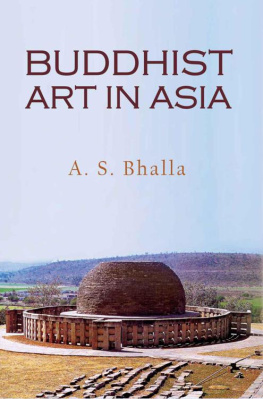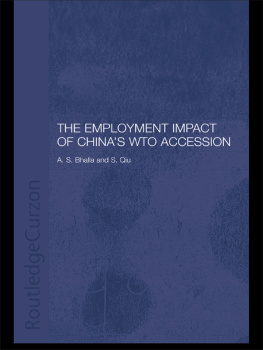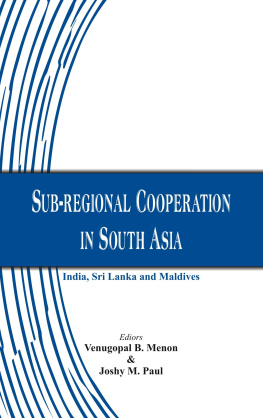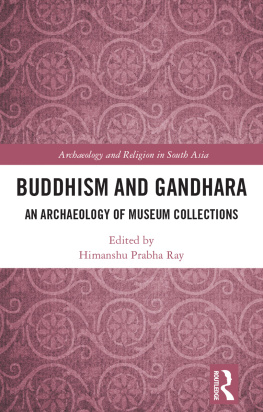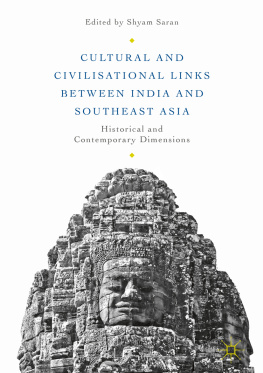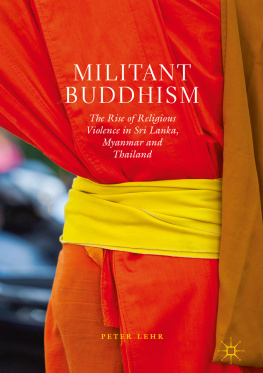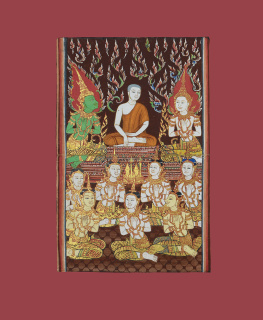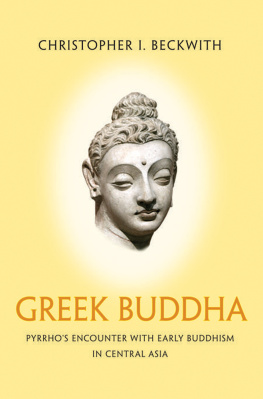About the Author
Dr AS Bhalla ( MA Cantab; Ph.D Manchester) is a former Fellow of Sidney Sussex College, Cambridge, UK. His recent publications include the Royal Tombs of India: 13 th to 18 th Century (Mapin, 2009); and Poverty and Exclusion of Minorities in China and India (Palgrave Macmillan, 2013).
To Praveen, Ranjan and Arman
A. S. Bhalla

BUDDHIST ART IN ASIA

Copyright A. S. Bhalla (2014)
The right of A. S. Bhalla to be identified as author of this work has been asserted by him in accordance with section 77 and 78 of the Copyright, Designs and Patents Act 1988.
All rights reserved. No part of this publication may be reproduced, stored in a retrieval system, or transmitted in any form or by any means, electronic, mechanical, photocopying, recording, or otherwise, without the prior permission of the publishers.
Any person who commits any unauthorized act in relation to this publication may be liable to criminal prosecution and civil claims for damages.
A CIP catalogue record for this title is available from the British Library.
ISB N 9781784550608
www.austinmacauley.com
First Published (2014)
Austin Macauley Publishers Ltd.
25 Canada Square
Canary Wharf
London
E14 5LB
Acknowledgments
The publisher and author acknowledge the following for their help and copyright clearance:
Archaeological Survey of India (ASI) (New Delhi) for Figs. 33 and 34 (Chapter 6) taken from Ajanta Murals: An Album of Eighty-five Reproductions in Colour edited by A. Ghosh (New Delhi, 1987) and for Fig. 39 supplied by the ASI.
Attinger SA of Neuchtel (Switzerland) for Fig. 59 (Chapter 9) taken from Thailande: Art et religion (Neuchtel, 1974), Audio-Visual Department (DAV) of the Library of the City of Chaux-de-Fonds, Fernand Perret Fund.
Terence Faircloth, Atelier Teee, Inc., California for Fig. 58 (Chapter 9) downloaded from the website:sacreddestinations.com.
Dr John Listopad of California State University Sacramento for Fig. 49 (Chapter 8) taken from Art from Thailand edited by Robert L. Brown (Mumbai, Marg Publications, December 1999).
British Museum, London, for Figs. 9, 10 and 11 (Chapter 2) and Figs. 30, 31 and 32 (Chapter 5), Trustees of the British Museum.
Kolkata Museum for Fig. 29 (Chapter 5), taken by the author.
Lahore Museum (Pakistan) for Fig. 6 (Chapter 2) taken by Ranjan Bhalla.
Oriental Museum, Lisbon (Portugal) and the Berardo Collection for Fig.1, taken by the author.
Wikipedia for Fig. 12 (Chapter 2).
Contents
The Stupas of
The Cave Temples o f
The Temples and Sculpture s of
The Temples and Paintings o f
The Temples o f
List of Figures and Tables
1. Bodhisattvas Lokesvara and Manjushri, China
2. Sarnath stupas, India
3. San Fa Si pagodas, Dali, China
4. A stupa, Wat Arun, Bangkok, Thailand
5. A Japanese pagoda, Nikko Toshogu Shrine
6. An emaciated Buddha, Gandhara, Pakistan
7. A standing Buddha, Sarnath, India
8. A Khmer Buddha, Angkor Thom, Cambodia
9. Buddha footprints, Amaravati, India
10. A medallion showing worship of Buddha relics, Amaravati, India
11 A relief showing worshippers, a throne and Buddhas feet, Amaravati, India
12. A rock painting from Sirigiya, Sri Lanka
13. Banteay Srei temple, Cambodia
14. Stone carvings, Banteay Srei
15. Mahabodhi temple, Bodhgaya
16. Granite railing, Bodhgaya Museum
17. Current railing around the temple
18. Daijokyo Buddha of Japan, Bodhgaya
19. Great Buddha, Kamakura, Japan
20. Tibetan temple and monastery, Bodhgaya
21. A Buddha statue and tantric decorations, Bhutanese temple
22. Clay carvings, Bhutanese temple
23. Dhamekh Stupa, Sarnath
24. Floral and geometric patterns on the Dhamekh stupa
25. A decorated pediment, Sarnath
26. Round stone pillars, Sarnath
27. Great Stupa, Sanchi
28. Northern gateway to the Great Stupa, Sanchi
29. A Bharhut yaksi
30. A limestone pillar showing the conversion of Nanda, Amaravati
31. Great Departure of Prince Siddharatha, Amaravati
32. Floral decoration on a limestone pillar, Amaravati
33. Round floral decorations, Ajanta
34. A close-up of an apsara, Ajanta
35. Carvings on the facade of Cave 19, Ajanta
36. Nagaraja and his consort, facade of Cave 19, Ajanta
37. Chaitya interior with a standing Buddha, Ajanta
38. Facade of Cave 10 (Carpenters cave), Ellora
39. A loving couple on the facade of the Karle monastery
40. A naga hood, Angkor Thom
41. Nagas on a pediment, Banteay Srei
42. General view of Angkor Wat
43. Painted ceiling and columns, Angkor Wat
44. A group of dancing apsaras, Angkor Wat
45. Demon gods, Angkor Thom
46. Bodhisattvas as guardians, Angkor Thom
47. Khmer army marching into battle, Bayon
48. A devata from the central sanctuary, Bayon
49. A jataka scene on a wall painting, Wat Ratchburana, Ayutthaya
50. Wat Mahathat behind a meditating Buddha, Ayutthaya
51. Khmer-style central tower, Wat Ratchburana, Ayutthaya
52. Stupas of Wat Ratchburana, Ayutthaya
53. Golden Buddha statue in royal attire, Wat Na Phra Men, Ayutthaya
54. A close-up of the reclining Buddha, Wat Po, Bangkok
55. Buddhas feet with mother-of-pearl inlay, Wat Po, Bangkok
56. Wat Arun from the river, Bangkok
57. Temple guardians, Wat Arun, Bangkok
58. General view of Wat Phra Keo, Bangkok
59. A mural painting depicting a scene from Buddhas life, Bangkok
Tables
Table 2.1
Ancient Indian dynasties and patronage of Buddhist art
Table 4.1
Differences between Sarnath and Mathura images of Buddha
Table 5.1
Characteristics of the railings in Sanchi, Bharhut, Amaravati and Bodhgaya
Table 7.1
Temples of Angkor
Preface
Buddhism, which originated in India in the sixth century BC, faded into near oblivion by the thirteenth century. However, it spread to other countries in Asia, and along with it, Buddhist art. Tracing the Indian influence on Buddhist art in Asia is a central theme of the book.
Why did Buddhism disappear in India? This question has not yet found a satisfactory answer. Some scholars and historians believe that Buddhism was so tolerant of other faiths that it was gradually reabsorbed by the Hindu tradition. It may have lasted as long as it received royal patronage during Ashokas reign and that of his successors. This religion was also popular among the mercantile community which provided financial support to the Buddhist temples and monasteries. The decline of the mercantile community may have lowered the status of Buddhism. Lack of resources to sustain a new religion may have further contributed to its downfall. The arrival of Islam in India in the thirteenth century was perhaps the final blow to Buddhism.
Chapter 1 presents a brief history of Buddhism in South Asia, Southeast Asia and East Asia as a background to a discussion of monuments (temples, monasteries, stupas), sculpture (Buddha statues, medallions and relief panels) as well as paintings in Ajanta, Bodhgaya, Ellora, Karle Sarnath and Sanchi in India, Angkor in Cambodia, and Ayutthaya and Bangkok in Thailand. It examines reasons for the spread and later downfall of Buddhism in India and its expansion in countries such as Burma (Myanmar), Cambodia, Sri Lanka and Thailand.
Chapter 2 discusses the patronage of Buddhist art by kings, rich merchants and ordinary people as well as Indian influence on Buddhist art in South Asia and the rest of Asia particularly Southeast Asia (that is, Cambodia, Indonesia and Thailand). There are wide variations in the features of Buddhist art (especially Buddha sculptures) across countries and regions. We examine whether these differences are due to history, culture, legends or geography.
Next page
